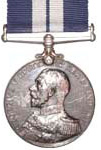Distinguished Service Medal (DSM)

Awarded to members of the Royal Navy and Royal Marines, and formerly also to personnel of other Commonwealth countries, up to and including the rank of chief petty officer. For bravery and resourcefulness on active service.
First established
By King George V, 14 October 1914.
WW1 recipient
C/ERA Ernest Edward Stevens, RN, gazetted 23 October 1914
‘Ernest Edward Stevens, Chief Engine Room Artificer (1st class), O.N. 269,451’ (Gazette supplement 28948) (An engine room artificer was a fitter, turner or boilermaker.)
Southampton-born Stevens had 9 siblings, and was 36 when he received the DSM. He went on to be awarded the DSC for services in submarines between 1 January and 30 June 1918 (Gazette supplement 30909). He was killed while on HMS E6 in the North Sea in December 1915, and is commemorated on the naval memorial and register at Portsmouth.
YNC Albert Fox, gazetted 23 October 1914
Despatch of Commodore Tyrwhitt for men of HMS Arethusa:
‘I cannot adequately express my satisfaction and pride at the spirit and ardour of my Officers and Ship's Company, who carried out their orders with the greatest alacrity under the most trying conditions, especially in view of the fact that the ship, newly built, had not been 48 hours out of the Dockyard before she was in action. It is difficult to specially pick out individuals, but the following came under my special observation.... Chief Yeoman of Signals Albert Fox, O.N.194656 (Po.), on fore bridge during entire action.’ (Gazette issue 28949)
A yeoman of signals (YNC) was concerned with planning, deployment and management of military tactical and strategic communications.
